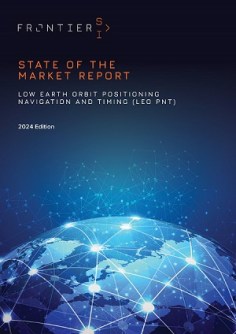
Low-Earth orbit is shaping up to be the next battleground for satellite-based positioning, navigation and timing efforts, according to a new LEO PNT report published by FrontierSI.
The State of the Market Report: Low-Earth Orbit Positioning, Navigation and Timing (LEO PNT) report outlines current and future systems and technologies that are, may be or will be used for LEO-based PNT, as well as the technical challenges that must be overcome.
“LEO PNT represents the next frontier in satellite navigation, offering enhanced reliability and performance for industries and communities,” said Graeme Kernich, FrontierSI CEO. “This report provides the insights needed to understand and shape the future of this transformative technology.”
PNT service provision, traditionally the preserve of governments, will increasingly be offered by the private sector as lower launch costs and technology improvements combine to make LEO PNT an attractive business proposition.
The report demonstrates that the future of PNT probably lies in a combination of private enterprise ventures and traditional government-led systems. Each has its advantages and disadvantages, with the market likely to determine in which direction the overall mix will head.
The means of delivering LEO PNT services can be divided into three categories:
- PNT-only services from dedicated satellite constellations;
- Those relying upon ‘signals of opportunity’ (SOP) from non-PNT satellite systems; and
- Those that will provide a hybrid of PNT and communications services.
Of course, the overall driver behind LEO PNT is the alternative it could provide to the current GNSS, which is dominated by half a dozen large, state-controlled systems such as the GPS (USA) and Galileo (Europe). These ubiquitously adopted systems, while excellent, carry sovereign risk — they are controlled by a handful of nations, are provided free of charge and could be denied or intentionally degraded in times of conflict or contention.
Independent PNT services provided by low-cost satellite constellations in LEO offer a potential alternative that is increasingly being seen as attractive by a wide range of potential users.
But the picture is not all roses. The FrontierSI report outlines concerns regarding the interoperability of different proposed systems, as well as the management of the required radio spectrum and governance issues. It points out that “Coordination among commercial, government, and multi-national players will be essential to ensure these systems can operate harmoniously”.

While the report mainly focuses on dedicated LEO PNT systems, it also delves into SOP using constellations such as Starlink. While early efforts in this area are achieving near-metre-level navigation accuracy under ideal conditions, there’s still a long way to go before they might be ready for commercial operation.
The report also compares the characteristics of different proposed LEO PNT systems with those of the traditional GNSS. Aspects covered include the determination of precise orbits, timescale issues, and ionospheric effects, the latter of which differ between LEO and higher orbits. There’s also the problem of the increased atmospheric drag that will be encountered by LEO satellites, which again has implications for precise orbit determination.
The proposed LEO PNT constellations would comprise very small satellites that would not be able to carry the heavy atomic clocks used by GNSS satellites, so alternative time synchronisation methods will need to be found. This might take the form of “time transfer from ground stations, GNSS or geostationary satellites, or employing optical inter-satellite links,” the report says.
There are quite a few players in the emerging LEO PNT space, and the report takes a look at each of them: Iridium STL, Xona Space and TrustPoint (all from the USA); JAXA and ArkEdge Space (Japan); Centispace, Geely and SatNet LEO (China); as well as ESA’s FutureNAV LEO-PNT In-orbit demonstration (Europe). There are also two emerging systems, Fergani Space (Turkey) and GNSSaS (UAE).
So far, only Iridium offers a commercial PNT service. Although it achieves a timing accuracy of less than 100 ns, its positioning accuracy is limited to metres to tens of metres because of the restricted number of satellites it has in LEO. A low number of satellites will not be a problem for other providers, with most of them planning to have between 200 and 500 satellites.
The report also ponders other important considerations, such as the availability of receiver technology and radio frequency spectrum allocation.
“This report is a foundational resource for anyone involved in satellite navigation, from policymakers and industry professionals to researchers and investors,” said Eldar Rubinov, FrontierSI’s Positioning & Geodesy Technical Lead and the report’s lead author.
“It is the basis from which we can track the evolution of LEO PNT technology and its implications across civilian and defence domains.”






